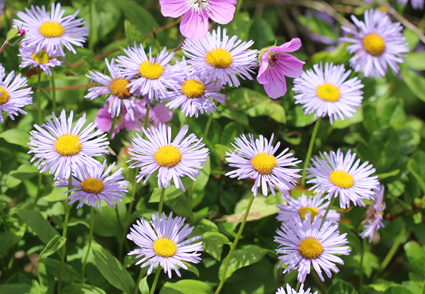Abstract
Erigeron multiradiatus (Asteraceae: Astereae: Conyzinae) and Tibetiodes himalaica (Asteraceae: Astereae: Asterinae) are often misidentified due to their morphological similarity and variation in some morphological characters. The present communication aims to resolve the identity crisis of these two species based on detailed morphological studies of freshly collected as well as herbarium specimens (including types), SEM studies of cypselas and molecular study with one nuclear and one chloroplast marker (ITS and trnLF). The morphological analysis showed that the two species differ in involucres and flower colour, with very clear differences in macro- and micro-morphological features of the cypselas. The molecular study also showed clear distinction between these two taxa. Additionally, a lectotype is designated for Erigeron multiradiatus.
References
- Bentham, G. & Hooker, J.D. (1876) Genera Plantarum, ad exemplaria imprimis in Herbariis Kewensibus servata definite, vol. 2 (1). Lovell Reeve & Co. and Williams & Norgate, London, pp. 163–533.
- Candolle, A.P de (1836) Prodromus systematis naturalis regni vegetabilis, vol. 5. Treuttel & Würtz, Paris.
- Chen, Y. & Brouillet, L. (2011) Erigeron. In: Wu, Z.Y., Raven, P.H. & Hong, D.Y. (Eds.) Flora of China, vols. 20–21. Science Press, Beijing & Missouri Botanical Garden Press, St. Louis, pp. 634–650.
- Chen, Y., Brouillet, L. & Semple, J.C. (2011) Aster. In: Wu, Z.Y., Raven, P.H. & Hong, D.Y. (Eds.) Flora of China, vols. 20–21. Science Press, Beijing & Missouri Botanical Garden Press, St. Louis, pp. 574–632.
- Compositae Working Group (CWG) (2024) Global Compositae Database. Available from: https://www.compositae.org/gcd (accessed 29 March 2024) https://doi.org/10.14284/411
- Clarke, C.B. (1876) Compositae Indicae. Thacker, Spink and Co., Calcutta & Thacker, Vining & Co., Bombay & Higginbotham & Co., Madras & W. Thacker & Co., London.
- Gogoi, R., Sherpa, N., Franklin Benjamin, J.H., Agrawala, D.K., Rai, S.K. & Dash, S.S. (2021) Flora of Sikkim – A Pictorial Guide. Botanical Survey of India, Kolkata & Forest and Environment Department of Sikkim, Gangtok.
- Grierson, A. (1964) A revision of the Asters of the Himalayan area. Notes from the Royal Botanic Garden, Edinburgh 26: 67–163.
- Hall, T.A. (1999) BioEdit: A User-Friendly Biological Sequence Alignment Editor and Analysis Program for Windows 95/98/NT. Nucleic Acids Symposium Series 41: 95–98.
- Jafari, F., Osaloo, S.K. & Mozaffarian, V. (2015) Molecular phylogeny of the tribe Astereae (Asteraceae) in SW Asia based on nrDNA ITS and cpDNA psbA-trnH sequences. Willdenowia 45 (1): 77–92. https://doi.org/10.3372/wi.45.45108
- Korolyuk, E., Makunin, A. & Matveeva, T. (2015) Relationships and generic delimitation of Eurasian genera of the subtribe Asterinae (Astereae, Asteraceae) using molecular phylogeny of ITS. Turkish Journal of Botany 39 (5): 808–824. https://doi.org/10.3906/bot-1410-12
- Li, W.P., Yang, F.S., Jivkova, T. & Yin, G.S. (2012) Phylogenetic relationships and generic delimitation of Eurasian Aster (Asteraceae: Astereae) inferred from ITS, ETS and trnL-F sequence data. Annals of Botany 109 (7): 1341–1357. https://doi.org/10.1093/aob/mcs054
- Nesom, G.L. (2020a) Metamyriactis (Asteraceae, Astereae), a new genus of Southeast Asian Asters. Phytoneuron 58: 1–36.
- Nesom, G.L. (2020b) Tibetiodes Nesom, Gen. Nov. (Asteraceae: Astereae), including 27 species of Himalayan Aster. Phytoneuron 63: 1–30.
- Nesom, G.L. (2020c) New genera from Asian Aster (Asteraceae: Astereae). Phytoneuron 64: 1–44.
- Nguyen, L.T., Schmidt, H.A., Von Haeseler, A. & Minh, B.Q. (2015) IQ-TREE: a fast and effective stochastic algorithm for estimating maximum-likelihood phylogenies. Molecular Biology and Evolution 32 (1): 268–274. https://doi.org/10.1093/molbev/msu300
- Onno, M. (1932) Geographisch-morphologische Studien über Aster alpinus L. und verwandte Arten. Bibliotheca Botanica 106: 1–83.
- Plants of the World Online (POWO) (2024) Plants of the World Online. Board of Trustees of the Royal Botanic Gardens, Kew. Available from: https://powo.science.kew.org/ (accessed 19 February 2024)
- Rambaut, A. (2016) FigTree 1.4.3. Computer program distributed by the author. Available from: http://tree.bio. ed.ac.uk/software/figtree (accessed 29 October 2024)
- Thompson, J.D., Higgins, D.G. & Gibson, T.J. (1994) CLUSTAL W: improving the sensitivity of progressive multiple sequence alignment through sequence weighting, position-specific gap penalties and weight matrix choice. Nucleic Acids Research 22 (22): 4673–4680. https://doi.org/10.1093/nar/22.22.4673
- Turland, N.J., Wiersema, J.H., Barrie, F.R., Greuter, W., Hawksworth, D.L., Herendeen, P.S., Knapp, S., Kusber, W.H., Li, D-Z., Marhold, K., May, T.W., Mcneill, J., Monro, A.M., Prado, J., Price, M.J. & Smith, G.F. (eds.) (2018) International Code of Nomenclature for algae, fungi and plants (Shenzhen Code) adopted by the Nineteenth International Botanical Congress Shenzhen, China, July 2017. Regnum Vegetabile 159. Koeltz Botanical Books, Glashütten. https://doi.org/10.12705/Code.2018


